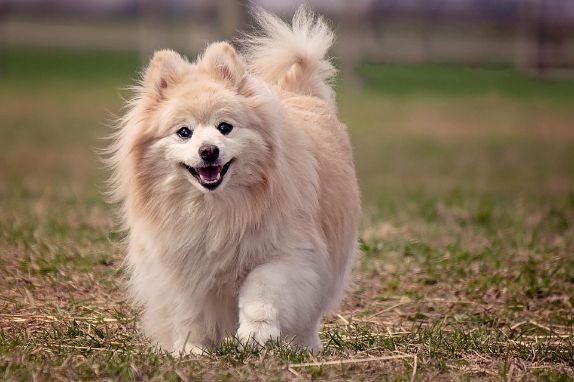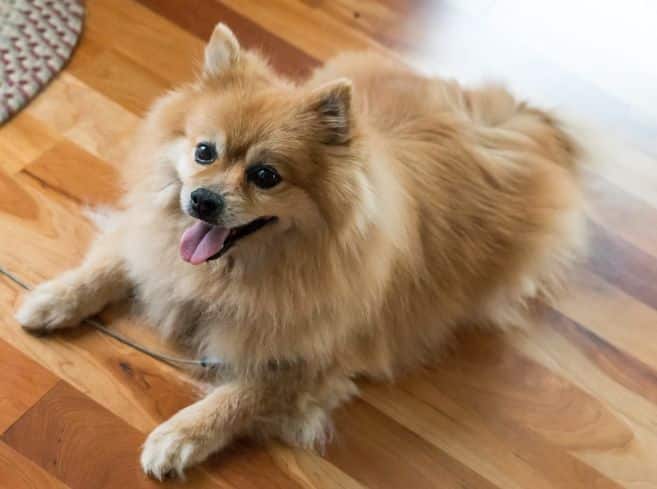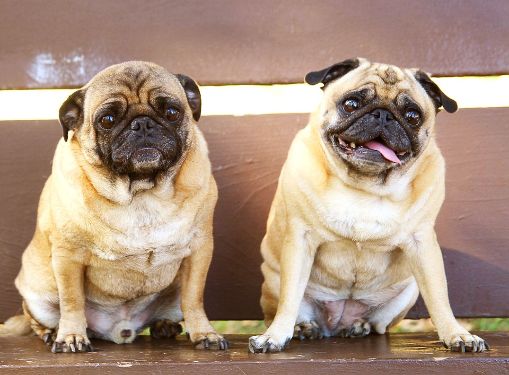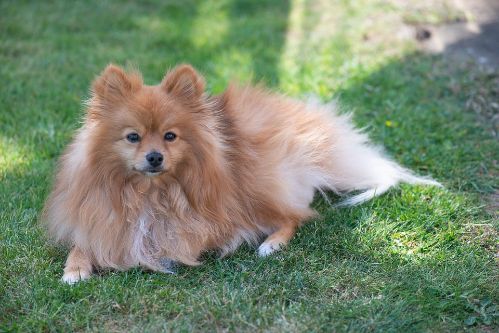We're an affiliate
We hope you love the products we recommend! Just so you know, we may collect a share of sales or other compensation from the links on this page at no additional cost to you. Thank you if you use our links, we really appreciate it!
If you’re planning on getting a Pomeranian, here’s a great article to get a hold of to know the most common health problems in Pomeranians.
Taking care of a dog will give your daily life more energy and excitement and give you a feeling of accomplishment. It is also essential to keep in mind that getting a dog means additional responsibilities as you will be taking care of a living being.

Before adopting a new dog, it is advised to research the breed, such as their lifestyle, how to train them, their diet, and other essential factors. It is also vital that you know the common Pomeranian health issues that may affect your dog while growing up.
It is also interesting to know their life expectancy and the things that you can do to ensure they live a happy, healthy, and long life.
If you are looking for a small, fluffy furbaby that is smart, obedient, and active, then a Pomeranian is perfect for you!
Read on as we will be discussing the common pomeranian health issues and the treatment for these. More importantly, we believe that prevention is better than cure, so we will be tackling what we can do to avoid these issues.
Overview of the Pomeranian
Pomeranians also called Poms, are feisty small toy dog breeds that are very friendly among humans and other pets. Many pet parents take care of a Pomeranian due to their loyalty and cute appearance. Although they have a small build, they can be a great house dog thanks to their bravery.

Standing at around 15 to 30 cm, this breed is well known for its fluff around its neck. They have a double coat, one soft and thin inner coat, and one thicker more prominent top coat. If you are not a fan of frequent vacuuming, then a Pom is not for you as they shed tremendously.
Pomeranians are great when it comes to socialization with people and other pets. They love meeting new people and befriending other animals they meet. Despite this friendly demeanor, they are excellent as watchdogs and will start to bark fearlessly if sensing any danger due to their curiosity and alertness.
Like most dog breeds, Poms need to be trained to socialize while they are still puppies. Exposing them to different people, environments, and skills while they are young will help in ensuring that they will grow up as excellent dogs.
If you like taking your pom everywhere you go even on long trips, you can get a pet stroller that will help in giving him a break whenever you feel he is getting tired throughout the journey. You can check our article on the best pet strollers to help you decide on which one to buy.

Top 10 Most Common Pomeranian Health Issues
Pomeranians are generally healthy and can live for around 12 to 16 years. Nevertheless, like many dog breeds, they can still suffer from health risks that need to be taken care of immediately.
Once your furbaby has reached his geriatric age, pomeranian health problems after age 7 to 9 will become more possible. During this age, it is advisable to bring him for a check-up with your vet twice a year to check if any health risks are present.

As pet parents, it is our job to care for our dogs, especially when they are sick. This section will discuss the most common health issues a Pomeranian may have and how to treat them. The knowledge of these health concerns, the symptoms, and the causes, will significantly help you in preventing these health risks.
1. Patella Luxation
This health concern is common in many toy dog breeds, such as Shih Tzu, Chihuahua, Pugs, and Pomeranian. The main culprit for this patella luxation, also known as slipping kneecaps, is genetics and how the bones are structured. This will make them prone to early osteoarthritis.

Found within the tendon of thigh muscles are the patella or kneecaps. The tendon is a tough inelastic band of tissue joining the bony attachment and the muscle.
If you notice that your pomeranian has back leg problems then they most likely have patella luxation, the patella will be loose and will move back and forth underneath the tendons.
The kneecap or the patella is a small bone in the knee area, hiding beneath the thigh muscles’ tendon. If your Pomeranian has patella luxation, the kneecaps get dislocated and start to slip in and out of this tendon.
He will limp on the affected leg either the front or back leg, and occasionally stretch it in an attempt to reassign the kneecap to its place.
It is advised to have your furbaby’s patella checked yearly to see if it is sliding in and out of the tendon, as it can progress worse as years pass by. If your furbaby is diagnosed with Patella Luxation, the only option for treatment is knee surgery.
How to Prevent Patella Luxation?
To prevent this health risk, you have to be keen when it comes to diet and exercise. By properly feeding your Pom with a well-balanced diet, they will have less risk of having calcium deficiency, which affects their bone strength.
Pomeranians should have patellas evaluated yearly as grading can become progressively worse with age.
By providing regular exercise, their limbs, and joints strengthen. However, strenuous jumping exercises can be harsh to their small limbs, so mild running will do.

There are also oral joint supplements for dogs that will not heal the luxation but will help delay the onset of arthritis after surgery and relieve pain and inflammation when the luxation happens or even after.
A supplement like Jope Joint chews is a good choice for Patella Luxation.
2. Tracheal Collapse
Another common health risk for small dogs is Tracheal Collapse. The trachea (or the windpipe) is made up of a circular group of cartilage, which allows mammals to breathe.
If these get weakened, they could collapse, resulting in becoming narrower. This makes your dog breathe harder due to the development of dry and harsh coughing and gagging.
There are three significant causes of tracheal collapse. Genetic disposition from over-breeding, infection, or obesity. Also, sometimes if the trachea gets constricted often because of a tight collar, it may result in tracheal collapse.

When it comes to treatment, it varies depending on the cause (genetics, infection, or obesity). Cough suppressants can help reduce irritation and inflammation from coughing.
Steroids are also a treatment option to reduce inflammation. If tracheal collapse is caused by obesity then weight loss is the first thing you should tackle.
Tracheal collapse is usually mild and can be treated easily but when symptoms are critical, surgery may be an option.
Affected dogs may cough after drinking water due to the changes in pressure in the tracheal column in addition to the discomfort caused.
How to Prevent Tracheal Collapse?
You can’t do much if the cause is a genetic disposition.
But you can prevent your Pom from having a tracheal collapse by using a harness instead of a collar. Also, keep in mind that obese Poms have greater chances of a Collapsed Trachea, so exercise and a proper diet are necessary.
3. Pharyngeal Gag Reflex
Pharyngeal gag reflex, or reverse sneezing, occurs when they suddenly have a rapid and forceful inhalation of air through their nose. Reverse sneezing got its name because Poms who have experienced this sound like they are attempting to take in a sneeze.
There are various causes for reverse sneezings, such as teeth infections, nasal irritation, and air irritants such as smoke, and pollen. Another reason for this health risk is an irritated larynx or palate, which can cause spasms in those areas.
4. Coat Loss
- Severe Hair Loss Syndrome
A coat loss risk known as Severe Hair Loss Syndrome (SHLS) can be a risk for Pomeranians. The fur will start to grow, looking normal, but as time passes by, it will begin to thin out, more prominent around the back and bottom area.
- Alopecia X
Alopecia X, also known as Black Skin Disease usually happens on puppies when there are excessive coats with no guard hairs that do not shed. When these coats are shed, there are still guard hairs left that can be irritating to them.
Another version of a similar condition happens at a later age, where the fur will start to grow, looking normal, but as time passes by, it will begin to thin out, starting from the back, and moving towards the bottom area. It is important to have the coat examined and determine the underlying issue to avoid worsening the risk.
Although we don’t really know what causes alopecia X, altered sex hormone metabolism can be a primary suggestive underlying cause.
Melatonin is a recommended treatment to stimulate hair growth.
How to Prevent Coat Loss?
The most effective way to prevent this health risk is through proper grooming and bathing.

5. Hypothyroidism
Thyroid glands produce thyroxine that all mammal bodies require and if it fails to manufacture enough, it can lead to hypothyroidism and itchiness. Unfortunately, this health risk is a common disease for Poms.
The following are the usual symptoms of hypothyroidism:
- Constipation
- Dry skin
- Weight gain
- Infertility
- Lower than-average body temperature
- Depression
- Low energy
- Dry thinning Hair Loss and loss of hair
- Abnormal thickening of the skin
- Skin discoloration
- Infections due to bacteria
To determine if the cause is hypothyroidism, first, the dogs will get their T3 and T4 tested by their veterinarian. Blood tests will get more accurate results because the symptoms stated above can also be caused by other canine health risks. Once determined that it is in fact hypothyroidism, your vet will most likely prescribe thyroxine medication.
Most dogs do not experience a low body temperature but they would have a very low tolerance to cold temperatures.
How to Prevent Hypothyroidism?
To prevent hypothyroidism, it is vital to keep the thyroids healthy. There are numerous multivitamins that contain Vitamin A, Vitamin D, zinc, and iodine that help in maintaining the flow of thyroxine in the body.
Also, adding more fiber to your dog’s diet can greatly increase the chances of preventing hypothyroidism. You can incorporate asparagus, green beans, spinach, and carrots which are rich in fiber.

6. Cushing’s Disease
Cushing’s Disease, also known as Hyperadrenocorticism, is common for canines who suffer from great amounts of stress and anxiety. This disease results in high levels of a hormone called cortisol and are usually accompanied by a tumor.
The following are the usual symptoms of hypothyroidism:
- Extreme thirst
- Excessive panting
- Increase in appetite
- Bloated stomach
- Lethargic
- Loss of hair
- Skin infections
- Infertility
- Obesity
Cushing’s disease can mostly affect adult dogs. Some puppies can contract it but the symptoms only appear once they reach adulthood.

If you can mark a check to the symptoms on the list above, call your vet as soon as possible. Unfortunately, Cushing’s Disease is not preventable; thus, once you have seen the symptoms, reach out to your vet immediately.
7. Heart Disease
Heart disease is common in all dogs and should be taken seriously even if it is just mild. Similar to human heart risks, Pomeranians can suffer from it if they have a poor genetic history, and poor lifestyles, such as obesity, lack of exercise, and little socialization.

How to Prevent Heart Disease?
With complete and nutritious meals, regular exercise, and routine checkups, dogs can prevent heart disease.
8. Idiopathic Epilepsy
Yes, you read that right! Canines can get epilepsy and seizures, too! There is one major difference between a seizure and epilepsy, frequency. If your pomeranian experienced it once or multiple times, it is a seizure. If it is ongoing, it is epilepsy.
The main triggering factors of Idiopathic Epilepsy are:
- Head injury
- Severe low blood sugar
- Water on the brain (hydrocephalic)
The main reason why some Pomeranians get head injuries is because of improper handling, resulting in risky drops.
Another reason is when a Pomeranian is left alone on a bed that is too high. Due to their small stature, they are most likely to fall over the bed and risk head injury.
When treating idiopathic epilepsy, the vet will rule out the triggering factors first. And since there is no cure for idiopathic epilepsy, vets usually prescribe anti-convulsants to regulate or decrease the frequency and severity of the seizures.

How to Prevent Idiopathic Epilepsy?
Since head injury is the number one cause of Idiopathic Epilepsy, it is recommended to have your home safe for dogs. Keep their bed in a low area, and eliminate objects that could be a risk for the head to bump into.
9. Idiopathic Hypoglycemia
Hypoglycemia is having very low blood sugar, and it is more common than you think. Glucose is the sugar that can be found in our body that is created when food is digested.
Hypoglycemia is mostly caused by poor diet and insufficient food for puppies. When a puppy requires to move more, usually when doing physical activities such as exercise and walking, they need more glucose to function.

A young puppy with hypoglycemia will lack energy since glucose fuels the body for energy. Without the energy-giving glucose, the puppy will begin to feel weak and lethargic. In severe cases, the puppy might even get a seizure, and in extreme cases, can become comatose and lethal.
Poms should undergo a blood glucose test first to have an accurate measurement of their blood glucose. This will help the vet know the right dosage for the treatment.
Intravenous or oral dextrose can be administered, and the vet will also advise on the quantity of carbohydrates the pom should have in a day.
How to Prevent Idiopathic Hypoglycemia?
With proper diet and exercise, Poms can live healthily without suffering from Idiopathic Hypoglycemia. It is advisable to give your furbaby small regular meals frequently, rather than three big meals in a day.
10. Cataracts
Cataracts limit your Pom’s ability to assess distances. Symptoms are cloudy eyes and swelling or discoloration around the eyes.
Cataracts are often likely to lead to blindness, so it is urgent to contact your vet for treatment and possible surgery as soon as you recognize the symptoms.
Unfortunately, cataracts are not preventable; thus, observing your dog’s eyes regularly is vital as they get older.

Taking care of this dog breed has risks because of Pomeranians’ possible common health problems, but it is all worth it.
The fulfillment you will get from having an adorable, life-long canine buddy is the best reward you could ask for.
Do you have any tips and tricks in mind that you would like us to tackle in the next article? Comment down below!




18 Responses
my pomeranian suddenly manifests difficulty of breathing after exposure to dust due house construction. can Nebulize her? whats the recommended nebulizing solution for pom 10 months old
It is best to have the vet check her for a proper diagnosis, they would then decide on the best approach to treat your dog.
What a wonderful site! Thank you! Is there anything you can recommend doing or giving your pom when they don’t want to eat? Sometimes my 9 year old, Teddy will since an entire day & eat nothing!?
Hello Eileen, really glad you like my site 🙂 I am not sure what kind of diet your Teddy is eating. Is it raw food, kibbles or wet food? Have you been trying different types of food with her? And has she always been like this? Some dogs are picky with food and you will need to try different flavors and different types of food with them until they find what they like the most! Hope this helps. If your dog is refusing to eat because of a health problem then definitely check with a vet on this.
Great website. My 9 year-old Pom hasn’t been feeling well of and on for about 7 weeks now. She stopped enjoying our daily walks and would just lag behind. Very low energy, having difficulty finding her treat when I drop it on the floor, drinking water more often, cloudy eyes; even had a couple of accidents on the floor. She’s at the vet hospital right now being diagnosed. I’m doing research while she’s there and found your website. Good information. Praying she’s okay
Hi Carolyn, really sorry to hear about your dog, please let me know the diagnosis results. I hope she gets well soon and I hope my article was able to help you with some good tips and information ♥️
Thank you for the great info
You’re most welcome glad I could help
Wow I’ve learned so much from this website!
Thank you so much for your comment, it means a lot to me to know that I am able to provide helpful information.
My Pom will be 16yrs old this year, & was just diagnosed with failing kidneys…
The vet made me buy canned Hills Science kidney food-
So far she won’t eat it- not surprised… I would love any feedback on this & if there is a healthier natural food diet for her I could make for her
Hi Kathy, my advice is to follow your vet’s recommendation. I am not a vet so I wouldn’t recommend something I do not know, what I would suggest is to find a way to get your dog to eat the wet food, some of the ways that I would recommend:
* You don’t have to put the full amount of wet food at once try to put it for him in 2 or 3 meals a day
* Mix it with his favorite dry food
* Or mix it with another favorite wet food
* Or mix it with his favorite treats
with time he will get used to the new wet food and he will start eating it without even mixing it with anything else.
I hope this helps 🙂
I have a Pom that is 14 with a collapsing trachea. He is the most finicky, picky eater in the world. I’ve got about 10 dog foods now but we usually end up giving him boiled chicken and bits of veggies. I’ve watched him go 3 days without eating with me changing dog foods constantly holding out for people food. He is the sweetest, most lovable dog in the world and I know I may not have a long time left with him so I do spoil him a tiny bit, okay I spoil him a lot. I just want him healthy and happy.
Hi Elizabeth, thank you for sharing your story with your lovely dog, I hope my article was a bit helpful. I am sure he is loved and spoiled 🙂 I hope he stays healthy and strong.
thanks for the info much appreciated
You are most welcome! happy to help 🙂
I have a 13 year old Male Pom. He is having episodes where he walks and all of a sudden will collapse lose all control of his functions. Pee and poo. Go totally limp tongue out like he died. Wakes up in about 5 minutes sometimes 2 minutes. And starts running around good. Do u have any idea. They want me to put him through heart exrays over $800. That does not say if they find anything. What should I do.
Hello Karen, I am so sorry to hear about your fur baby. I am not 100% sure but your dog might be going through fainting or syncope, and these could come from cardiac and / or neurological problems. Only a vet and proper testing can help your dog, so my advise to you is to listen to your vet and conduct all the proper tests that are needed, maybe consider pet insurance if you have one where you live. I hope your dog gets well soon.